Update Dec. 9: I’ve made a couple corrections per request by François Frères.
Vinoscenti spend a lot of time debating the minutiae of varietals, vintages and vineyards, but what about the scrutinizing the whole package? I am of course referring to the barrels that wines are typically aged in, handcrafted vessels used by France’s prolific wine industry to add and mellow flavors as a wine matures.
One rainy afternoon, we headed to François Frères Tonnellerie, a cooperage founded by Joseph François in 1910 and celebrating its 100th anniversary this year. The tonnellerie is currently managed by 4th generation family members, and works with a number of prominent Burgundy and international winemakers. Daily production is now 140-160 barrels a day (compared to two per day in 1910), with an annual production of about 40.000 barrels and gross sales of €2,4 million!
Clockwise: raw oak tree trunks; demonstrating American oak cuts on the left, French oak cuts on the right; lining up staves for the barrel body; pallets of aging staves
As we ogled at the phalanx of burly men wielding mallets, our tour guide Roman patiently walked us through the process of transforming a tree trunk into a wine cask. The tonnellerie uses wood from French, American and Hungarian oak trees, which are generally between 80 and 150 years old at the time of felling. With French oak, only about 20% of the wood is actually used for making barrels; the remainder will be used as firewood or pressed into paper. American oaks provide a greater yield of about 80% usable wood. The difference lies in the density of the wood stocks. French oak is much less dense and must be split by hand along the grain of the wood. On the other hand, American oak is denser and can be cut against the grain with a saw. With a blue marker, Roman diagrammed the closely spaced cuts for American oak, versus the wedges required for French oak. He added that the spacing of the tree rings indicates how much the wood will breathe. If the rings are thinner, there will be more aeration and the barrel will be better suited for pinot noirs and other reds.
Each tree is cut into meter-length staves, then the staves are stacked in tiered piles outside, where they will be seasoned and aged for a minimum of two years. After months of exposure to sun, rain and snow, the wood turns dark and drops from about 80 to 20% humidity. “Some coopers spray water onto their staves to speed the process, but we only use the natural elements here,” explained Roman. Hence, since rainfall varies from year to year, different vintages of casks will have slightly different properties. At the end of the seasoning, samples from the staves are sent to labs for mold testing. About 29-35 staves are used for each barrel, and 0.7 m³ of wood is needed to make ten barrel bodies (excluding the heads).
Clockwise: aligned staves look sort of like hoop skirts; a tonnelier rolls a barrel toward a bucket of flaming coals; the finished interior of a toasted barrel; a barrel in the process of toasting
Inside the cooperage, the air was warm and sweet with the scent of scorching wood. Tonneliers set the staves into metal rings, then set them over buckets of flaming coals. Depending on the preferences of the winemaker, barrels can be given a light to heavy toasting. The intensity of the flames may vary, but the duration of the toasting does not.
Clockwise: barrel head pieces are pressed together without any glue or sealant; coopers hammer the finishing touches on barrels; Roman sells the UNISG class an old barrel; custom logos and designs can be burned onto the barrel heads with lasers
Next, the rings are permanently attached to the barrel, and a bunghole is cut into the side. With expert precision, a cooper arranges staves for the barrel head into the proper dimensions and the staves are pressed together by a machine without the use of glue. The inside of the barrel is wiped with a putty sealant made of flour, water and sawdust. (There’s also a gluten-free version.) Using lasers, the top of the barrel can be inscribed with custom logos and text. Finally, high-pressure leak testing is conducted on each barrel. If a leak is found, the cooper will mend it handily by making a crack in the barrel head, driving another wedge of wood inside and lopping off the excess.
As we approached the door, there was a line of old, used barrels sitting against the exterior of the warehouse. “Hold on, how much would one of those barrels cost?” a student asked. “Wait, only €30??” (A new barrel costs about €560 600.) A buzz rose from the class, and we made a split-second decision: let’s buy a barrel! Everyone pitched in €1 for the cause, and Roman gave us a crash course in how to roll a barrel. With the aid of several hands, the barrel was rolled out into the parking lot and onto our bus. It will be converted into a smoker for the next class pig roast.


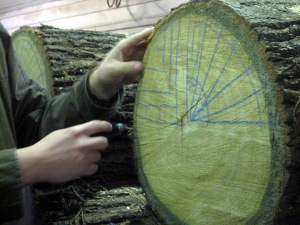
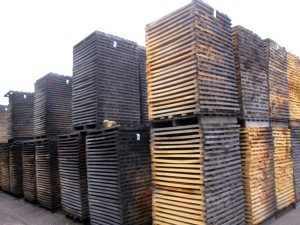
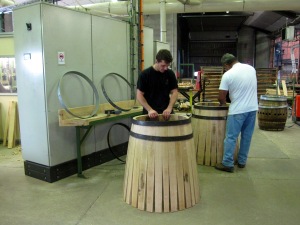




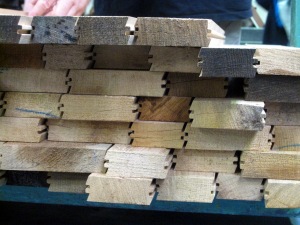

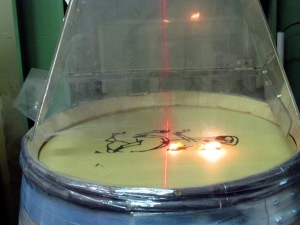

Nice work here. This is one of the visits I have still not made in the wine world.
We work with Shawn and John Guilliams in Napa who make a delicate Cab blend. John was a cooper prior to launching the estate and tells me that he never re-toasts barrels because the additional toasting converts the sugars in the wood and gives a flavor that is reminiscent of peanut butter to the wines. His comment was that it’s not a bad flavor, but it has nothing to do with where the wine is from. It’s a thought I share only so that you can look for that smell when you roast the pig in your barrel!
Cheers,
Damien
Aha, that is valuable information to have. We just figured that the barrel would impart some kind of red-wine flavor to the pork, maybe we’ll have to rethink our seasoning strategy.
According to my calculations a barrel is worth 60Eu (not the 500 retail?) or about $US 100 so 30Eu is 1/2 price of new. Still a bargain. Also 10 barrels worth of wood weigh about 1000 lbs + the metal hoops so the barrel is worth less than $1/lb LTL shipping in the US is about $.25 to $2.00 per lb depending on you discount. Thus there is probably no chance that this business will exist in 10 years … so very sad that the the retailer is making all the money.